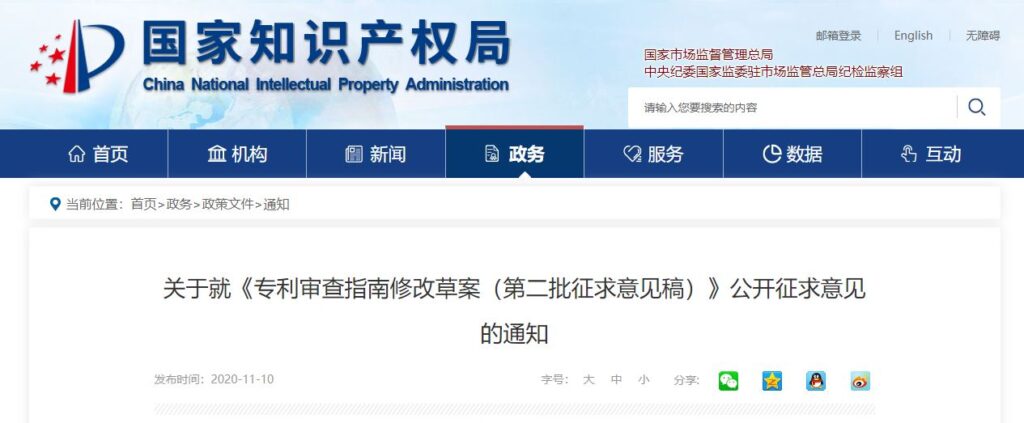China Releases Draft Revised Patent Examination Guidelines for Comment
On November 10, 2020, the Chinese National Intellectual Property Administration (CNIPA) released the Draft Revised Patent Examination Guidelines (Second Draft for Solicitation of Comments) (专利审查指南修改草案(第二批征求意见稿)). The Patent Examination Guidelines are the Chinese equivalent of the USPTO’s Manual of Patent Examining Procedure. Highlights include: excluding artificial intelligence entities from inventorship; clarifies patentable subject matter for diagnostic methods; clarifies prior art found on the Internet; clarifies technical means for inventions related to computer programs; and adds involuntary deferred examination for invention patent applications when both utility model and invention patent applications are filed simultaneously.

Artificial Intelligence
Chapter 1, Part I: 4.1.2 is amended in the draft to exclude AI entities from being named as an inventor. Inventors must be individuals and not entities, organizations or AI entities.
Diagnostic Methods
The amended guidelines clarify that inventions not belonging to diagnostic methods and therefore subject matter eligible include:
information processing method the immediate purpose of which is only to obtain an intermediate result by apparatus having the information processing capabilities such as a computer rather than to obtain the diagnostic result or health condition.
-Chapter 1, Part II: 4. 3.1. 2
Accordingly, a “method of measuring blood pressure” was removed as an example of a diagnostic method in 4.3.1.1.
Online Prior Art
Chapter 3, Part II: 2.1.2.1 defines online prior art:
(2) Materials on the Internet or in other online databases
Materials on the Internet or in other online databases refer to materials saved in the form of data and transferred via the networks, such as text, pictures, or audios or videos.The materials on the Internet or in other online databases should be obtained through legal means. It does not matter whether the acquirement of the materials requires a password or payment, or whether the materials is known to anyone.
The publication date of the materials on the Internet or in other online databases is generally based on the issue date, unless there is other evidence to prove its publication date. For books, periodicals, dissertations and other publications published online, the publication date shall be the online issue date or publication date recorded on the webpage. If the above publications also have paper publications with the same content at the same time, the publication date can also be determined according to the printing date of the paper publication, and usually the earliest publication date that can be determined shall prevail. For materials on the webpage where the issue date is not clear or the issue date is suspicious, the issue date and modification date recorded in the log file, the index date given by the search engine, the date displayed by the Internet archives service, and the time stamp information or on the mirror website Information such as the issue date of the copied information displayed above can be referred to determine the publication date.
Where only a specific month or year is indicated as the printing date, publish date or issue date, the last day of the month or year shall be regarded as the date of disclosure.
Technical Means in Software
Chapter 9, Part II:2 add the following paragraphs:
If the solution of an invention application utilizes technical means implemented by a computer, it would necessarily solve a technical problem and obtain a technical effect. Technical means implemented by the computer refer to the following cases.
Case I, the solution recites information processing device such as computer, network device and programmable device, etc., and content of realizing control and process by the aforementioned information processing device executing computer program.
Case II, the solution does not include information processing device such as computer, network device and programmable device, etc., but recites content of realizing control and process by the aforementioned information processing device executing computer program. For example, the solution recites the content of implementing a series of controls for each stage of the industrial process, measurement or test process by executing an industrial process, measurement or test process control program. For another example, the solution recites the content of performing a series of technical processing on the technical data by executing a technical data processing program. For another example, the solution recites the implementation of a series of settings or adjustments to various components of the computer system by executing a system internal performance improvement program.
Deferred Examination of Invention Patent Applications
Applicants with mechanical invention often file for a utility model (UM) and invention patent application simultaneously. Applicants get the best of both worlds: a UM for quick enforcement (and fallback if an invention patent doesn’t grant) and then potentially a more solid substantively examined invention patent a few years later (with method claims not available in a UM). However, a new provision in the draft guidelines would potentially put an end to this:
Where an applicant files on the same day (means the date of filing) applications for both patent for utility model and patent for invention relating to the identical invention-creation, if the patent for utility model has been granted, the examination of the corresponding application for patent for invention will be deferred.
These draft guidelines would need to be clarified – is the deferral indefinite or up to the maximum 3 years mentioned in a preceding paragraph? If one abandons the UM, will the invention patent application then be examined? Either way, this negates the benefit of filing for both UM and invention patent applications simultaneously.
The full list of changes can be found here: 《专利审查指南修改草案(第二批征求意见稿)》修改对照表 (Chinese only). Comments are due December 10, 2020.
Back to All Resources

